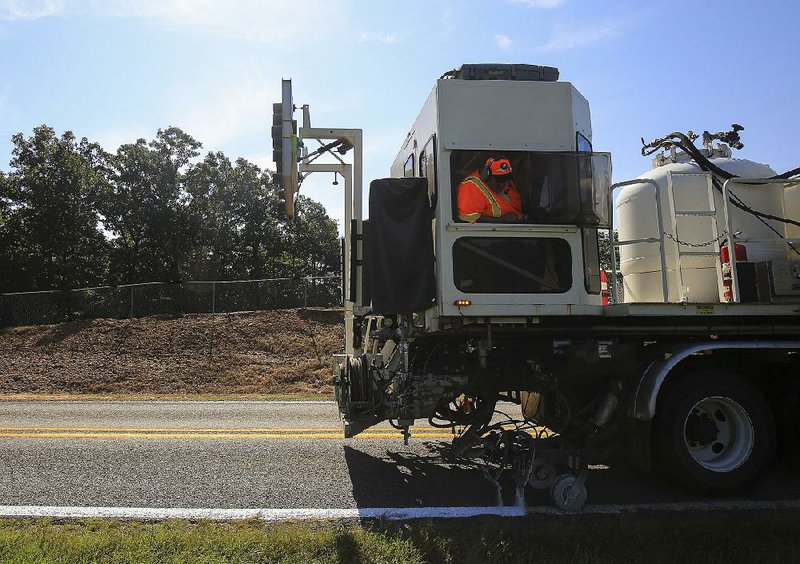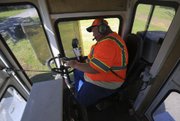The Arkansas Highway and Transportation Department is abandoning high-tech pavement stripe technology and using the savings to double its complement of traditional pavement striping crews that it says will make state highways safer and still save the agency money.
The new striping, while not as advanced, will be wider -- 6 inches instead of 4 inches -- and use more material that will make it brighter and easier to see, especially in rain, than the regular paint striping material the crews now use, according to state highway officials.
Doubling the number of pavement striping crews to 12 from the six the department now has will allow the agency to re-stripe all 16,000 miles of state highways every two years instead of every four, as is the practice now, they say.
Studies reviewed by the Federal Highway Administration show the wider striping to be especially beneficial on rural highways.
One "crash frequency analysis suggests that wider edge lines are effective in reducing the frequency of crashes on rural two-lane highways, especially with regard to relevant target crashes such as single-vehicle crashes and run-off-the-road crashes," according to the federal agency.
It also found that "increasing pavement marking width may provide more benefits than those gained from installing and/or maintaining markings with relatively high retroreflectivity levels."
Retroreflectivity refers to how road surfaces are made to reflect light back toward its source, such as a car's headlights.
The Federal Highway Administration also has suggested wider pavement markings as a low-cost tool to aid older drivers, which are an increasing segment of the nation's motorists as the population ages.
"Bigger and brighter signs, more conspicuous signals, and wider stripes are among the innovations making highways safer for older road users," according to the agency.
In Arkansas, residents age 65 and older account for 16 percent of the population of 2.9 million, according to the U.S. Census Bureau.
But those older residents account for a much higher percentage of the state's 2.1 million drivers. Drivers age 65 and older total 548,322, or 1 in 5 Arkansans who have a driver's license, according to the latest figures from the Arkansas Finance and Administration Department.
Those older Arkansas drivers include at least two members of the Arkansas Highway Commission. Scott Bennett, the department director, briefed the commission members on the new striping strategy at a commission meeting earlier this month.
Commission members Tom Schueck of Little Rock and Dick Trammel of Rogers welcomed the move.
Schueck, who is 75, singled out the doubling of the agency's complement of pavement striping crews.
"That's great," he said. "As an elderly driver that drives at night, I want to tell you I appreciate that."
Increased safety was a factor in the department's move, but so was saving money, state highway officials acknowledge.
"Overall, it's a cost savings even though we're going to bring that work back inside and hire more crews and, ultimately, it's a big safety improvement," Bennett told the commission members.
The department has been using a tape-like thermoplastic material that was put down by outside contractors on construction projects primarily focused on interstates and major U.S. highways.
It is a much brighter material than the paint-like material the department typically uses. At issue is the retroreflectivity levels, which is the amount of light the material reflects back when a light, such as from a headlight, hits it.
The thermoplastic tape has strong retroreflectivity properties, but it comes at a cost -- about $3 per linear foot, according to Tony Sullivan, assistant chief of operations for the department.
But the department adopted it about the same time it was moving to heavier equipment to increase the agency's effectiveness at snow and ice removal. The bigger trucks use what are called belly plows, which are fastened under the truck rather than in front of the truck. The location allows the use of the truck's weight to help the plows more efficiently remove snow and ice from road surfaces.
In addition to removing the snow and ice, those bigger trucks tend to scrape up that expensive tape.
"It comes up sometimes on the first time you have to plow it in snow and ice," Bennett said. "You plow everything up."
The enhanced striping that will replace the tape not only will be wider but also will contain more retroreflectivity material than the paint the department now uses. Though its retroreflectivity value isn't as high as the tape it will replace, state officials believe that will be offset by the wider stripe.
And it can be put down at a much lower cost, about 60 cents per linear foot, Sullivan said.
"It will stand up better to our snow plows, and will be one-fifth the cost," Sullivan said.
The department now spends about $7 million annually on the tape, he said. Equipping and staffing six additional pavement striping crews will costs about $4 million annually.
The change won't happen overnight, though. The change in strategy is reflected in the department's proposed budget for the next two years.
But Bennett said it likely will take another two years to acquire the equipment and train the personnel for the six additional crews.
"When you spec and order these striping trucks, it's usually nine months to a year away to have it manufactured and delivered," he said. "We'll be pushing them to manufacture and get that many of these new ones delivered. We usually buy one a year to replace an old one. To buy six new ones and replace an old one, it's going to stretch" the supplier.
Metro on 09/26/2016

